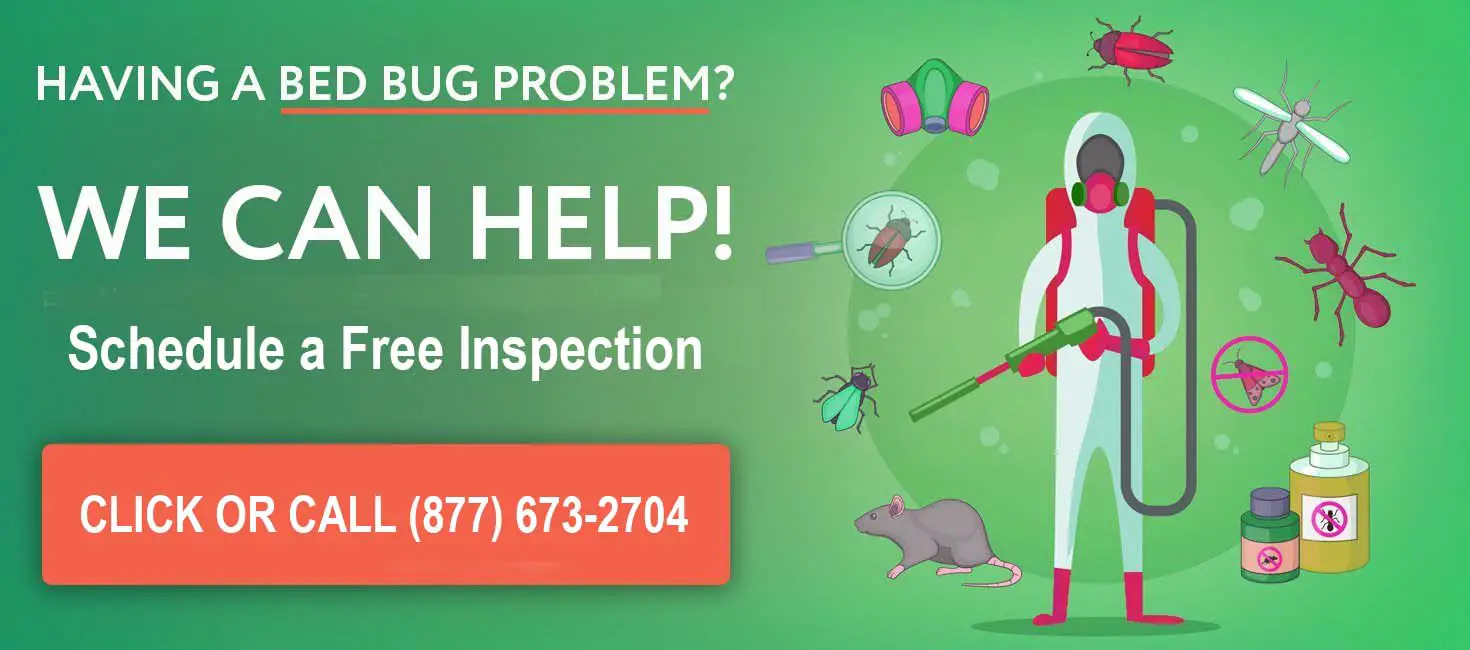Bed bugs can be a pain to remove, even with professional help it can take up to 3 or 4 treatment remedies to fully remove an infestation, this is because bed bugs can live several months all the way up to 1 year without feeding. Meaning if any one single bed bug is missed during the removal process they can have eggs and grow into another infestation. When it comes to home remedies, generally speaking there are two types, treatments for bites and methods used to completely remove an infestation.
overview
This guide describes several home remedies for getting rid of bed bugs. While it is possible to treat small infestations yourself, it is better to use a professional who can confirm the presence of bed bugs, determine the size of the infestation, and the proper treatment methods. If you live in an apartment building, always ask for an inspection since it is required that all adjacent apartments be inspected once in infestation is confirmed.
If you want to confirm the presence of bed bugs yourself, capture and take an insect for identification to a local University or Cooperative extension (call first) or send an insect to Cornell Diagnostic Laboratory.
During the early stages of a bed bug infestation they
are easier to spot and kill vs. later on when they have had a chance to hide in walls, cracks and crevices.
Home remedies for bed bugs include insecticides and bed bug traps as described below. The better approach is to purchase a bed bug kit that contains instructions and the multiple products to do the job correctly.
In general, it isn't very effective to try to eliminate bed bugs by yourself. Any approach (even professionals) requires 2 or more treatments. Sometimes bed bugs can release a smell called alarm pheromones, if you put some baking soda in the area it should help with the smell.
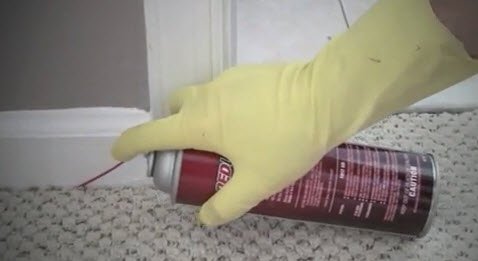 Removing Bed Bugs Using Bedlam Spray.
Removing Bed Bugs Using Bedlam Spray.table of contents
- Overview
- Basic Information to Know About Bites.
- Bite Remedies
- Bed Bugs Treatment Methods That Don't Work
- Where Are They Hiding?
- Sprays/Spray Bottles and Mattress Covers
- Instructions for Removing Bed Bugs Forever
- Chemical Free Treatment
- Brochures
bite basics
Bedbug bites are actually not bites. The bed bugs feed on humans and their blood. These pests use a tube called a stylet to puncture the skin in search of a capillary or blood vessel where they can draw the blood meal.
Most people will either have no skin reaction to a bedbug bite or will see a round red papule with a clear center. There can be one bite or many. The most common symptom is itch. If you itch the bites, it could introduce bacteria into the area, causing an infection.
Remedies for Bed Bug Bites
Several products are available to help with bite itch. One solution for an itchy bite is to apply tea tree oil and other helpful essential oils. Tea tree oil helps with anti-pain, anti-swelling, and anti-itching qualities. Most treatments are either made specifically for this type of itch such as Aveeno or you can purchase an anti-itch cream in your local drug store that is made to treat insect bites.
If you suspect a minor infection you can try an anti-biotic ointment such as neosporyn. Calamine location might also help to relieve the itch. If the skin fails to heal in 2 to 4 days, then visit your Doctor as an oral anti-biotic or stronger ointment may be needed.
bed bug treatment methods that do not work
One of the least effective methods for killing bed bugs is insect baits, while effective for killing other insects such as ants and cockroaches, they are not effective in eliminating bed bugs. This is because the "bait" is not interesting to bed bugs since they only feed on blood and are attracted to carbon dioxide when you breathe. Bug bombs also do not work as they do not penetrate deep enough into cracks and crevices to be broadly effective.
Boric Acid (Borax) is also an ineffective way to remove bed bugs so cross it off your home remedy list.
Other home remedies to get rid of bed bugs that do not work include: cedar oil and other natural oils — these products claim to kill bed bugs, but only cause the bugs to scatter out of sight and hide in cracks in walls and floors.
Dryer sheets are also ineffective.
where do they hide
-IN BEDDING, THE MATTRESS, FURNITURE, ETC.
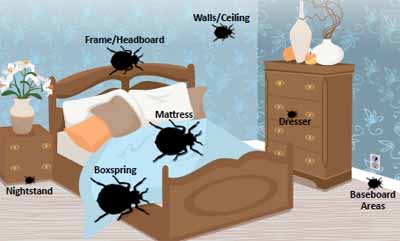 Bed Bug Hiding Spots on Furniture in the Bedroom
Bed Bug Hiding Spots on Furniture in the BedroomIt is important to identify all areas where bed bugs may be hiding. During the day, they hide in any available cracks, starting with the mattress seams, under the mattress label, box spring and bed frame. They also hide inside hollow bed legs.
As these areas fill up with bed bugs, skins that have molted, and bed bug feces and egg shells, bedbugs will seek other areas to hide. They will then move on to adjoining furniture, and the cracks between the floor and walls.
BED BUG SPRAYS AND MATTRESS COVERS
The following tips provide information on home remedies for getting rid of bed bugs. There are also some good products on the market that can be relatively inexpensive. For example, the best mattress bed bug spray, Sterifab, is under $10. The best crack and crevice spray, Phantom, is also relatively inexpensive.
The key to using homemade bed bug remedies or purchased products is to be thorough. Inspect every inch of a room, wash every item you can, place any item you can in the dryer, and throw out any clutter, and you have a fighting change.
There are two fundamental types of bed bug kits, with purchase based on individual preference vs effectiveness.
Also be sure to purchase and use bed bugs mattress covers after treatment. This will trap any bed bugs eggs you might miss.
Treating bed bugs
STEP BY STEP INSTRUCTIONS TO HELP CURE AN INFESTATION
1. Remove, bag and seal all blankets, linen, bed coverings etc. These will all need to be washed on the hottest setting and then placed n the dryer for 30 minutes at a high heat setting. This will kill both the bed bugs and their eggs.
2. Vacuum the entire room. Use the crevice tools around the edges of the room. You cannot suck up bedbug eggs with a vacuum, but it is a good way to get rid or live bugs that you can spot. Only remove the vacuum bag in the room being treated to avoid spreading any bugs.
3. Treat and seal the mattress and box spring. Treat the mattress and box spring with a mattress safe insecticide spray such as Sterifab or a naturally produced spray such as Bug Patrol. Both will kill bed bugs and their eggs. Treat the mattress first, seal it in a zipper cover that is bed bug approved such as Allerzip, and then move it to a safe area, such as a hallway just outside the room. Be sure to treat along seams, and under the mattress label. If you have one, use a hand steamer to steam along all seams. Steam will kill bed bugs and bedbug eggs. Do not soak to avoid mold.
Once the mattress is removed from the room treat the box spring. For the box spring remove or fold back the cloth that covers the bottom. After treatment, be sure to let dry and then seal in a zippered box spring cover. After treating the mattress move it to a "safe" area just outside the room. Do the same with the box spring. If you can only afford one cover, zip the box spring.
4. Use the spray product you purchased to treat any cracks in the bed frame and treat/check any head board. Take it apart if you can. From there, move to any furniture, pictures etc that are near the bed. Be sure to empty and pull out drawers. Throw out what you can. Do not use liquids inside electronics. Either throw out electronics, or place them in a heat chamber suppled by your exterminator which will super heat the items to a temperature of 120 degrees. If you can, dispose of any item that could possibly allow bedbugs to hide inside.
5. Use the spray on areas in the house such as cracks, common hiding places(listed above), wallpaper etc. If you have one, use a hand steamer as another layer of protection on things such as carpets and make sure to check curtains too.
6. Spread the Bed Bug dust around the edges of the room. Dust sticks to any late hatching eggs you might have missed. Spread dust under furniture as well.
CHEMICAL FREE METHODS USED TO TREAT BED BUGS
- If you live an apartment, bed bugs could spread to units above, below and next to yours. See our bed bugs apartment guide for legal and apartment bedbug treatment advice. You may need to notify your neighbors of the problem, particularly if bed bugs are coming through the walls into your apartment.
- Every week pack your blankets, sheets and other washable bedding and wash in hot water followed by 20 minutes in the dryer.
- Make good use of your vacuum cleaner. The crevice tool in particular can be used to suck up any bed bugs permanently. Use a brush to nudge them out of mattress seams/cracks and vacuum them up. You can also use a putty knife or playing card to nudge the bed bugs into an area where you can vacuum them up. You can also simply crush each bedbug with a paper towel or catch them with sticky tape. This is highly ineffective since you will most likely never find every bug.
Vacuum around and under furniture. Empty drawers that are next to the bed and be sure to vacuum inside, under and around all tracks. Dispose of the vacuum bag in the room being treated in a plastic bag (preferably a big Ziploc bag) that you tie and dispose of outside of the home or apartment. - Heat is one of the more effective bed bug remedies. The best way to do this is with a hand steamer. Preference is for one with multiple steam holds. Bed bugs and bed bug eggs are killed at 118ºF held for at least 20 minutes.
As an alternative, portable heaters are widely used by pest control experts and others as an effective method to treat bed bugs. A PackTite heater is similar to a duffel bag that has a heater designed to produce enough heat to kill bed bugs.
Professional exterminators effectively use portable heaters in a sealed room. Fans are used to spread the heat evenly throughout the room. Heat is applied for 4 or more hours. - If you spot clusters of bed bug eggs, which are small whitish oval pin head size specs, use clear package tape to pick them up. Place tape on top of each cluster and peal up. Dispose in a plastic bag, preferably one you can seal such as a Ziploc bag.
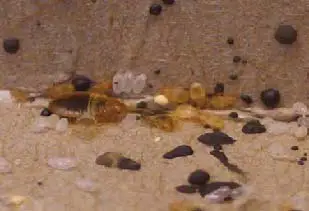 Picture of Bed Bugs and Their Eggs
Picture of Bed Bugs and Their Eggs6. Seal any cracks and crevices with caulk. Any cracks in the wall, or along where the floor meets the wall are ripe for bed bugs to hide or spread from an adjoining apartment. Also tighten all light switch and cable plate covers. Take down any ripped wallpaper. The more hiding places you remove, the better.
7. Dispose of any clutter. Newspapers and magazines are all hiding places for bed bugs. If you do opt for treatment, clutter blocking walls etc can make a bed bug treatment program less effective.
8. Move the bed at least 6 inches from the wall and any nearby furniture. Make sure no blankets are touching the floor. Place homemade bed bug traps under each bed leg or buy inexpensive climb up interceptors. (see picture at bottom). These interceptors will help to keep bed bugs off of the bed (they aren't 100%, but they will help). Add a thin layer of talcum powder to the outer well on the bowls for added protection.
using heat to treat bed bugs naturally
Heat can be an effective way to kill bed bugs. The downside of heat is that it has no residual effect. If you miss any area, additional treatments will be needed. Bed bugs will die if exposed to heat at 118F for 20 minutes (eggs require 118F for 90 minutes).
There are three methods for achieving this level of heat in the home.
1. Clothes Dryer: A clothes dryer loosely filled will kill bed bugs and eggs in 30 minutes. Use this method for shoes, bedding toys and other dryer appropriate items, particularly those that would be damaged by spray.
2. Portable Heater: A PackTite heater is similar to a duffel bag that has a heater designed to produce enough heat to kill bed bugs. It is idea for heating an entire suitcase after a trip or for holding household items.
3. Steamer: A hand held steamer will generate the required heat. The downside is the inability to get the steam deep into cracks or with possible damage to surfaces that cannot withstand steam heat due to moisture.
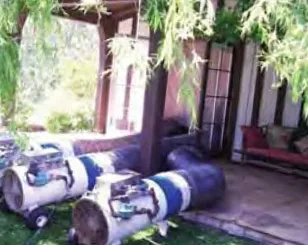 Professional Bed Bug Heat Pumps Outside Treated Home
Professional Bed Bug Heat Pumps Outside Treated Home
PEST CONTROL EXPERTS
Killing bed bugs is hard, even for an expert, which is why we recommend going this route. To save money and to find an experienced exterminator, we suggest calling a national network such as Home Advisor. Before being accepted to the network companies are pre-screened, licensed and insured. Compare costs and proposed treatment methods to local exterminators who can be found on our list of experienced local bed bug experts.
BROCHURES
Each of these free brochures are filled with additional pictures bite examples such as photos of rashes, skin reactions, mattress signs and information.
"Using Heat to Kill Bed Bugs"
Written by: Dini Miller, Ph. D
"Help! I think I Have Bed Bugs"
Anything from tips to methods on identifying a bed bug infestation, and what steps to take afterwards.
Written by: Ohio State University
Ask a Question or Share Your Bed Bug Experience With Others
Do you have a question or great story about bed bugs? Share it!
What Other Visitors Have Said About Bed Bugs
Click below to see contributions from other visitors to this page...
Using Mouth Wash to Kill Bed Bugs Not rated yet
I was recently informed that some schools are suggesting the use of antiseptic mouth wash to treat lice.
realizing that bed bugs are similar in nature, …
